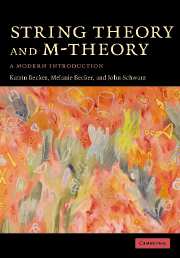Book contents
- Frontmatter
- Contents
- Preface
- 1 Introduction
- 2 The bosonic string
- 3 Conformal field theory and string interactions
- 4 Strings with world-sheet supersymmetry
- 5 Strings with space-time supersymmetry
- 6 T-duality and D-branes
- 7 The heterotic string
- 8 M-theory and string duality
- 9 String geometry
- 10 Flux compactifications
- 11 Black holes in string theory
- 12 Gauge theory/string theory dualities
- Bibliographic discussion
- Bibliography
- Index
10 - Flux compactifications
Published online by Cambridge University Press: 05 September 2012
- Frontmatter
- Contents
- Preface
- 1 Introduction
- 2 The bosonic string
- 3 Conformal field theory and string interactions
- 4 Strings with world-sheet supersymmetry
- 5 Strings with space-time supersymmetry
- 6 T-duality and D-branes
- 7 The heterotic string
- 8 M-theory and string duality
- 9 String geometry
- 10 Flux compactifications
- 11 Black holes in string theory
- 12 Gauge theory/string theory dualities
- Bibliographic discussion
- Bibliography
- Index
Summary
Moduli-space problem
The previous chapter described Calabi–Yau compactification for a product manifold M4 × M. When the ten-dimensional heterotic string is compactified on such a manifold the resulting low-energy effective action has N = 1 supersymmetry, which makes it phenomenologically attractive in a number of respects. Certain specific Calabi–Yau compactifications even lead to three-generation models.
An unrealistic feature of these models is that they contain massless scalars with undetermined vacuum expectation values (vevs). Therefore, they do not make specific predictions for many physical quantities such as coupling constants. These scalar fields are called moduli fields, since their vevs are moduli for which there is no potential in the low-energy four-dimensional effective action. This moduli-space problem or moduli-stabilization problem has been recognized, but not emphasized, in the traditional string theory literature. This situation changed with the discovery of string dualities and recognition of the key role that branes play in string theory.
As discussed in Chapter 8, the moduli-space problem already arises for simple circle compactification of D = 11 supergravity, where the size of the circle is a modulus, dual to the vev of the type IIA dilaton, which is undetermined. A similar problem, in a more complicated setting, appears for the volume of the compact space in conventional Calabi–Yau compactifications of any superstring theory. In this case the size of the internal manifold cannot be determined.
- Type
- Chapter
- Information
- String Theory and M-TheoryA Modern Introduction, pp. 456 - 548Publisher: Cambridge University PressPrint publication year: 2006

